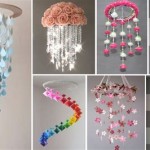Unique Decorating Ideas to Personalize Your Living Space
Decorating a living space offers the opportunity to express individuality and create an environment that reflects personal style. Beyond conventional approaches, exploring unique decorating ideas can transform a house into a home, imbuing it with character and making it a comfortable and stimulating place to live. This article delves into several distinctive decorating concepts, focusing on their implementation and the impact they can have on the overall aesthetic of a room.
Embracing Upcycled and Repurposed Materials
One path to unique decor lies in the realm of upcycling and repurposing. This approach not only contributes to sustainability but also injects a sense of history and originality into a space. Rather than discarding old items, considering their potential for transformation can yield surprising and delightful results. A vintage suitcase, for example, can be repurposed into a unique side table, offering both storage and visual interest. Similarly, old wooden pallets, often discarded by businesses, can be sanded, painted, and transformed into headboards, coffee tables, or even vertical gardens. The key to success in upcycling is to identify the intrinsic appeal of the original object and enhance it through creative modification.
The process often begins with scavenging and observation. Flea markets, antique stores, and even roadside finds can yield unexpected treasures. A rusty old ladder, for example, can be cleaned, painted, and leaned against a wall to serve as a quirky shelving unit. Glass jars, once destined for the recycling bin, can be repurposed as vases, candle holders, or even pendant lights. The possibilities are limited only by imagination and a willingness to experiment.
When working with repurposed materials, safety is paramount. Ensure that all items are thoroughly cleaned and free of harmful substances. If repurposing electrical components, consult with a qualified electrician to ensure safety and compliance with local regulations. Sanding and painting may be required to create a finished and polished look. The goal is to transform the raw material into a functional and aesthetically pleasing element of the decor.
Upcycled decor often blends seamlessly with various design styles. It can add a touch of rustic charm to a modern minimalist space, or it can enhance the vintage appeal of a more traditional setting. The key is to select items that complement the existing decor and that reflect the overall design aesthetic. A repurposed wooden crate, for example, might look out of place in a sleek, ultra-modern apartment, but it could be a perfect addition to a farmhouse-style kitchen.
Beyond the aesthetic and environmental benefits, upcycling can also be a cost-effective way to decorate. Many salvaged items can be obtained for free or at a minimal cost, allowing for creative expression without breaking the bank. This is particularly appealing for individuals on a tight budget who still want to create a unique and personalized living space.
Incorporating Personalized Art and Textiles
Another way to inject individuality into a living space is through the incorporation of personalized art and textiles. Rather than relying solely on mass-produced artwork, consider creating or commissioning pieces that are deeply meaningful and reflective of personal experiences and interests. This could involve framing personal photographs, displaying children’s artwork, or even creating original pieces using various art mediums.
Personalized textiles can also add a unique touch to a room. Consider commissioning a custom-made quilt featuring family heirlooms or creating throw pillows using fabrics that hold special significance. Embroidery, tie-dye, and other textile arts can be used to embellish existing items, transforming ordinary cushions, curtains, and tablecloths into unique works of art. The possibilities are vast and allow for a high degree of customization.
When selecting personalized art, consider the scale and placement of the pieces. A large canvas featuring a family portrait, for example, can serve as a focal point in a living room. Smaller framed photographs can be arranged in a gallery wall, creating a visually stimulating display. The key is to arrange the artwork in a way that is both aesthetically pleasing and meaningful.
The same principles apply to personalized textiles. A custom-made rug featuring a unique pattern can define a seating area in a living room. Throw pillows with embroidered designs can add a pop of color and personality to a sofa. Curtains made from a special fabric can filter light and create a warm and inviting atmosphere. The goal is to integrate the personalized textiles seamlessly into the existing decor.
Furthermore, consider supporting local artists and artisans. Commissioning a piece of artwork or a handcrafted textile not only adds a unique touch to a home but also supports the creative community. Local art fairs and craft markets are excellent places to find unique and affordable pieces that reflect the character of the region.
Digital tools and online platforms now offer numerous avenues for creating personalized art. Services that print images onto canvas, create custom wallpaper designs, or even generate abstract art based on user input are readily available. These tools provide individuals with the ability to create truly unique pieces that are tailored to their personal taste and preferences.
Playing with Textures, Patterns, and Unexpected Color Combinations
Beyond the use of specific materials and objects, playing with textures, patterns, and unexpected color combinations can also create a unique and visually stimulating living space. Mixing different textures, such as combining smooth surfaces with rough ones, can add depth and interest to a room. Layering patterns, such as pairing a floral print with a geometric design, can create a dynamic and eclectic look. And experimenting with unexpected color combinations, such as pairing contrasting hues or using unconventional color palettes, can inject personality and vibrancy into a space.
When working with textures, consider layering different materials to create a tactile experience. A living room might feature a plush velvet sofa, a woven rug, and a smooth glass coffee table. The contrast between these different textures creates visual interest and invites touch. Similarly, a bedroom might incorporate a linen duvet cover, a knitted throw blanket, and a sheepskin rug. The layering of textures creates a sense of warmth and comfort.
Pattern mixing can be intimidating, but the key is to find patterns that complement each other in terms of scale and color. A small-scale floral print might pair well with a larger-scale geometric design, as long as the colors are harmonious. Alternatively, different patterns can be unified by a common color palette. For example, a room might feature a striped rug, a floral wallpaper, and a polka-dot curtain, all in shades of blue and white. The repetition of the color palette creates a sense of cohesion.
Experimenting with unexpected color combinations can be a bold move, but it can also pay off handsomely. Consider pairing colors that are traditionally considered to be clashing, such as orange and purple, or green and pink. Alternatively, explore unconventional color palettes, such as using muted tones or incorporating unexpected pops of color in unexpected places. The key is to trust your instincts and to create a color scheme that is personally appealing.
Color theory can be a helpful guide when experimenting with color combinations. Understanding the relationships between different colors on the color wheel can help to create harmonious and visually balanced palettes. Complementary colors, such as blue and orange, create a vibrant contrast. Analogous colors, such as blue, blue-green, and green, create a sense of harmony. Triadic colors, such as red, yellow, and blue, create a bold and dynamic effect.
Lighting plays a crucial role in shaping the perception of textures, patterns, and colors. Warm lighting tends to enhance warm colors and textures, while cool lighting tends to accentuate cool colors and smooth surfaces. Experimenting with different types of lighting, such as ambient lighting, task lighting, and accent lighting, can dramatically alter the overall feel of a room.
Ultimately, unique decorating ideas are about embracing creativity and expressing personal style. By exploring upcycled materials, incorporating personalized art and textiles, and playing with textures, patterns, and color combinations, it is possible to transform a living space into a reflection of individual identity and preferences.

8 Unique Home Decor Ideas How To Decorate Your With Personality

30 Easy And Unexpected Living Room Decorating Ideas Simple Decor Decoration

Unique Fall Decor Ideas To Make Your Home Cozy And Inviting Miss Mv

35 Stylish Family Room Design Ideas Easy Decorating Tips For Rooms

Modern Apartment Decor How To Decorate Your Be Unique

60 Easy And Chic Home Decor Ideas To Try From Designers

3 Unique Decorating Ideas The Inspired Room

30 Unique Decorating Ideas So Much Better With Age

16 Unique And Fun Decorating Ideas Mmm 266 Block Party Keeping It Simple

Guest Post 10 Amazing Low Budget Home Decorating Ideas For Summer Aaublog
Related Posts







